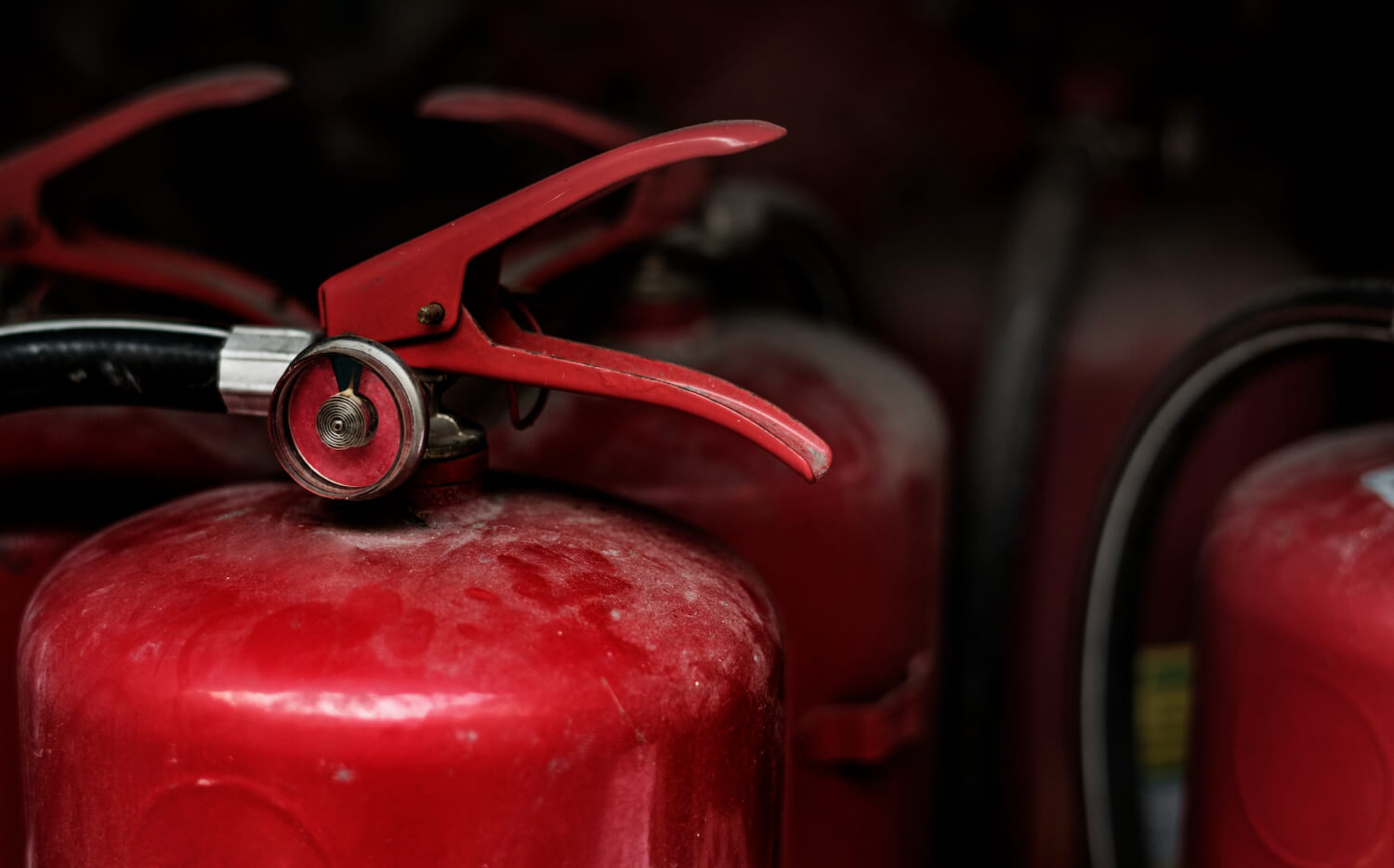Not all fires are created equal. In fact, fires are classified according to the type of fuel or material they burn, and understanding the different classes of fire is key to extinguishing fires safely and effectively. Grabbing the wrong type of fire extinguisher in an emergency can actually create additional problems and make things worse. But using the correct extinguisher is the most effective way to quickly extinguish a small fire at the workplace or at home.
A quick intro to the theory of fire
Before we get into the different types of fire, it’s worth understanding the basics of how fires ‘work’. For combustion to take place, four elements need to be present:
- Fuel
- Oxygen
- Heat
- Chemical chain reaction
These four elements make up what is known as the ‘fire tetrahedron’. Firefighting is done by breaking down the fire tetrahedron. There are three ways that this can be done:
Cooling: Lowering the fire temperature below what is needed for combustion
Smothering: Limiting or stopping the supply of oxygen
Starving: Removing the combustible material
With most fires, it’s impossible to remove the combustible material, so firefighting methods concentrate on cooling and smothering. This is where understanding the classification of fire becomes important, as different classes of fire require different types of fire extinguishers to cool or smother them.
The classes of fire
Fires are classified according to the types of fuel they burn:
Class A
Class A fires burn ordinary combustibles such as wood, paper, rubbish, or anything else that leaves an ash. Water works best to extinguish a Class A fire.
Class B
Class B fires are fuelled by flammable or combustible liquids, including oil, gasoline, and other similar materials. Smothering, which depletes the oxygen supply, works best to extinguish Class B fires.
Class C
Class C fires are known as energised electrical fires. Always de-energise the circuit first, and then use a non-conductive extinguishing agent, such as carbon dioxide (CO2).
Class D
Class D fires are combustible metal fires. Magnesium and titanium are the most common types of metal fires. Once a metal ignites, do not attempt to use water to extinguish it. Only use a dry powder extinguishing agent. Dry powder agents work by smothering and heat absorption.
Class K
Class K fires are fires including cooking oils, grease, or animal fat and can be extinguished using a fire blanket.
An easy way to remember these types of fires is: Class A leaves Ash, Class B Boils, Class C has Current, Class D has Dense material, and Class K is for Kitchen.
Why is it important to know which class of fire you’re dealing with?
Knowing which fire extinguisher to use on which class of fire is an essential element of fire safety. It’s important to position the correct type of fire extinguisher close to potential ignition sources of related fire classes.
For example, it makes sense to provide CO2 extinguishers in server rooms or near electrical panels, as these are best for extinguishing Class C fires (energised electrical fires). On the other hand, water extinguishers should be mounted in or near storage rooms containing stacks of paper and cardboard, as these are best for extinguishing Class A fires (ordinary combustibles).
Using the incorrect extinguisher can have dire consequences. For example, using a water extinguisher on a Class E (electrical) fire creates a severe electrocution risk to the user, as water conducts electricity. Apart from shocking the person using the extinguisher, using a water extinguisher on an electrical fire can also do further damage to the circuits.
Different types of fire extinguishers
Fire extinguishers are identifiable by their colour-coded labels, which indicate the contents of the extinguisher, the operating instructions, and the classes of fire on which it can be used.
Refer to the quick-reference table below to see which extinguisher is recommended for use on each class of fire:
| CLASS | MATERIAL | BEST EXTINGUISHER | ALTERNATIVE |
| A | Wood, paper, plastic, textiles, and solids | Water | DCP |
| B | Flammable liquids and gases | Foam | DCP |
| C | Electrical | CO2 | DCP |
| D | Soft or special metals | Specially formulated DCP powders | Water mist |
| K | High temperature cooking oils and fats | Fire blanket, CO2 | Foam |
Water extinguisher (red label)
Water extinguishers are best for Class A fires. Water is used in a cooling or quenching effect to reduce the temperature of the burning material below its ignition temperature.
Do not use on Class B fires (combustible liquids), Class C fires (electrical fires), or Class K fires (kitchen fires involving grease or hot oil).
Foam extinguisher (cream label)
Foam fire extinguishers are best for Class B fires (combustible liquids like oil or petrol). These extinguishers discharge a foam solution that extinguishes a fire in the following ways:
- It floats across the surface of the burning liquid and prevents the fuel from vaporising (vapour suppression).
- The foam blanket forms a barrier between the fuel and oxygen (smothering or starvation of oxygen).
- The water and foam concentrate converts into steam and absorbs heat from the flames (cooling).
- The foam forms a blanket over the fuel, preventing it from re-igniting.
Foam fire extinguishers are not to be used on electrical fires, as the foam solution is water based.
CO2 extinguisher (black label)
CO2 (carbon dioxide) fire extinguishers are best for Class B (flammable liquids) and Class C (electrical) fires. They can also be used on Class K (kitchen) fires. When carbon dioxide is discharged onto a fire, it forms a dense cloud that displaces the air surrounding the fuel. This interrupts the combustion process by reducing the amount of oxygen that can reach the fuel. A blanket of CO2 over the surface of a liquid fuel can also disrupt the fuel’s ability to vaporise.
CO2 extinguishers aren’t recommended for use on Class A fires as water extinguishers are much more effective for putting out these fires.
DCP extinguisher (blue label)
DCP (dry chemical powder) extinguisher agents are formulated for use on Class A, Class B, Class C, and Class D fires. DCP extinguishers deliver a stream of very finely ground particles onto the fire.
Dry chemical extinguishers work in two ways. Firstly, the dry chemicals interrupt the chemical chain reaction that occurs within the combustion process. Secondly, the large surface area of the finely ground dry chemicals allows it to absorb large quantities of heat, creating a cooling effect.
DCP fire extinguishers are not recommended for use on sensitive electronic and electrical equipment (such as computers or electrical switchboards).
Fire blankets
Fire blankets are the first line of defense in fighting kitchen fires (Class K) involving oil pans and grease. Read our full article on fire blankets for more information.
Be prepared for any fire emergency
Absolute Health Services stocks fire extinguishers including foam extinguishers, water extinguishers, DCP extinguishers, and CO2 extinguishers. Visit our fire extinguisher page for more information or contact us to purchase extinguishers for your home or workplace.
We also provide annual accredited fire extinguisher servicing as mandated by municipal bylaws and the Occupational Health and Safety Act.




